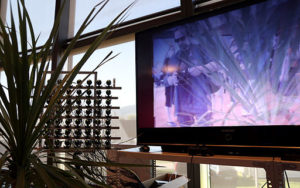
Image: Light-field photography at Ars Electronica 2013 at Brucknerhaus, Linz, Upper Austria. The original file on Wikimedia states that it has annotations, and that one could move the mouse pointer over the image to see them. It appears this is a light field photograph taken of the photographer as he stood in front of a camera array seen at the left. Attribution: By Manfred Werner – Tsui (Own work) [CC BY-SA 3.0 (http://creativecommons.org/licenses/by-sa/3.0)], via Wikimedia Commons
Light field lens arrays remind many of the compound eyes of insects.
VIDEO: 1 min. 15 sec. The insect vision project at the University of Adelaide, Australia, showed off a multiple lens camera in a 2008 video, describing it as a demonstration of how the compound eye of an insect sees the world:
As a caveat for the above video, another video from the University of Adelaide, on its Insect Vision project, is included at the end of this article, lest the impression is left that an insect, which has no focusing mechanism nor an iris, sees objects clearly, which is thought to be inaccurate by the robotic engineers in that video.
Light field photography was impractical without fast algorithms and processing units.
The arthropod (e.g., insects, crustaceans) eye is built quite differently from the vertebrate eye (and mollusk eye). Arthropod eyes are called compound eyes because they are made up of repeating units, the ommatidia, each of which functions as a separate visual receptor.
Above quote from: The Compound Eye – Kimball’s Biology Pages
Have you ever considered how an insect sees the world? Scientists tell us that an insect’s eye, known as a “compound” eye, is made up of lots of little eye-type cells, the ommatidia, which, in appearance, resemble a honeycomb.
Each cell processes light differently from the next. Light is seen according to the cell’s position in the eye, and the many light sources reaching it.
Unlike the human eye, a compound eye cell does not rotate (except in connection with the action of the insect), and does not focus.
With a new type of camera, the light field camera, we finally we have a fairly practical analogy of how an insect might see the world. The light field camera is a multi-lens (plenoptic) camera. Its function is to gather plenty of data from light sources.
Scientists believe the compound eye cell cannot focus. That’s where the plenoptic camera improves on the vision of insects. With the plenoptic camera, each bit of data can be brought into focus.
The chances of taking a perfect photograph are vastly improved with a light field camera. Autofocus may have chosen the wrong image subject to focus on. The photographer, subject, or camera may have moved. In either case, the image has been blurred.
With the large amount of data in a light field image, that imperfect photograph may potentially be processed to bring a fuzzy part of an image into perfect focus. The blurred light field images can be refocused digitally and quickly. Important images can thus be salvaged.
Light field photography is an old idea whose time has come.
According to Wikipedia, the idea of light field photography was first studied in 1908, by Gabriel Lippman. He tried to capture fast-moving images by using more than one lens. Each lens would see the image from a different angle. Each image would be lit by a different light source. The images could then be combined. The final image would have improved focus.
Various ways of accomplishing light field photography have been tried. But not until recently, about 2010, did technology advance far enough to meet the practical demands of light field photography.
What now has made light field photography practical?
- affordable multi-lens types of technology,
- refocusing software, and
- fast graphics processing computer hardware.
In this collection of articles, you’ll see information about each of these 3 advances in technology.
You’ll see that the number of micro-lenses in a plenoptic camera can be huge, a miracle of engineering in itself. That’s the plenoptic part.
You’ll see that the captured information is paired with software which focuses that information into a single image, computationally. That’s the refocusing part.
But perhaps the most ground-breaking advance that is bringing light field photography into the mainstream is a digital hardware advance. The light field information collected is vast. It is only practical when paired with an extremely fast computer.
At the time Adobe first developed a light field algorithm, they tried using multiple Central Processing Units (CPUs). Images could not be processed fast enough.
By 2007, Adobe had a prototype. But commercial versions were years away.
Today, those algorithms can be rendered at twice the speed of the North American 60 Hz electric current. That’s 120 Hz.
Adobe had started out using multiple CPUs. Nvidia’s Graphic Processing Unit (GPU) was a turning point. It allowed high-speed texture-mapping. This was in 2012.
To see what has led to the present-day light field advances, please visit the next page.
Also, don’t miss the videos in the subsequent pages. You’ll learn about the history of light field technology. Then, you’ll see how computational “light field” photography might be used in fields such as medicine, science, and education.



